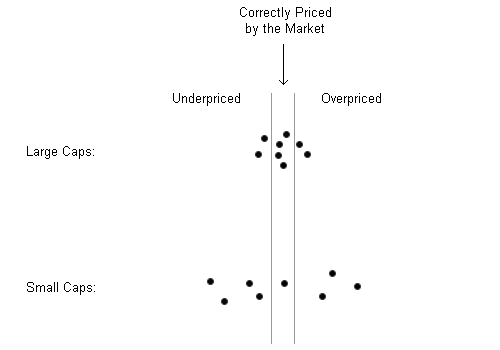Why Does Small Value Do Well?
Before you tilt your portfolio in the direction of Small Value, you ought to have some logical idea about why it has done well in the past and whether the trend is likely to continue in the future.
The usual explanation is that, as a compensation for extra risk, Small beats Big and Value beats Growth; therefore Small Value beats everything.
But take a look at the data for inflation-adjusted annualized returns for 1927-2005:
| Value | Growth |
| Large Cap | 9.21% | 6.17% |
| Small Cap | 12.13% | 5.77% |
| TSM: | 6.72% |
If Small beats Big, then Small Growth should beat Big Growth... but it doesn't: Small Growth has the worst performance of all.
A Different Theory
So here's an alternative theory, inspired by The Efficient Frontier.
Consider how investors view the different corners of the market:
| Value | Growth |
| Large Cap | Well-known
boring businesses | Well-known
exciting businesses |
| Small Cap | Unknown
boring businesses | The next Microsoft
is in here somewhere! |
The less positive the connotation, the better.
The absolutely bland Small Value companies have nothing going for them besides their intrinsic value, based on their ability to make profits - which is the only place that long-term stock returns can come from.
But paying a premium for a positive connotation will hurt you; and
Small Growth is the worst of all, because it's infested with really exciting companies that offer the hope of amazing returns.
On average these hopes won't materialize; but the price of the hope - the premium you have to pay for the stock, above the companies' intrinsic value - results in a drag on your returns.
(This is like playing roulette in a casino, where your odds are 50/50 minus a little bit for the house: the "little bit" is the price of hope, and it's why you lose.)
In other words, Small Value doesn't select winners so much as reject losers - the kind of companies that produce more excitement than profit (or more buzz than honey).
And Another Different Theory
Finally, here's the cleanest explanation yet. It's based on a view of the market explained by David Swensen in
this lecture at Yale.
Swensen says that market efficiency varies between asset classes, with large caps in particular being more accurately priced than small caps:

Now, to the extent that a value index will include the underpriced companies and exclude the overpriced ones,
| Value | Growth |
| Large Cap | Underpriced | Overpriced |
| Small Cap | More Underpriced | More Overpriced |
or in terms of performance:
| Value | Growth |
| Large Cap | Good | Bad |
| Small Cap | Best | Worst |
Note that this makes Small Value seem like a free lunch - an effortless way to select underpriced securities and beat the market - and if free lunches exist at all they aren't supposed to last very long.
So as more people decide to tilt toward Small Value, you might expect the P/E ratios of small caps to rise, until the Small Value advantage is gone.
Incidentally, this approach can be extended beyond small caps (or micro caps, which are even better) and applied to any asset class where you think the market may not be very efficient at assigning correct prices.
Emerging markets may be one such area; another may be recent IPOs (which DFA apparently underweights,
believing them to be mainly overpriced).
|